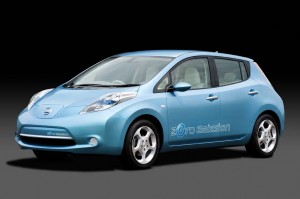Nissan is starting to spotlight the upcoming launch of its completely redesigned Leaf battery-electric vehicle.
Make that headlight the new EV. What the second-largest Japanese makers calls a “first glimpse at the next-generation Leaf” zeroes on the new BEVs twin lamps. With an LED light bar for running lights, what appear to be twin LED headlamps look far more conventional than the bubble lights found on the current Nissan Leaf.
No surprise, Nissan is expected to make the 2018 remake a bit less quirky than the gen-one Leaf, although it will remain visually distinct from the rest of the maker’s line-up. “It’s definitely a big step up from the current car,” a high-level Nissan official tells TheDetroitBureau.com.
In a Thursday news release, Nissan says, “This “teaser” image, released via social media channels and to current LEAF owners, is the first in a series of photos and informational briefs scheduled this summer in preparation for the global reveal of the new Nissan Leaf later this year.”
Expect to see it all come together sometime around September with a splashy media reveal, insiders have suggested. In the meantime, those interested in following what Nissan calls “the conversation” about the new BEV can follow through Twitter using the hashtags: #ElectrifyTheWorld #Nissan #LEAF
(Nissan hit by Wannacry ransomware attack. Click Here for the story.)
What have we been able to pick up already? Beyond the more stylish design, several things really should matter:
- Recently retired Nissan global creative director Shiro Nakamura told TheDetroitBureau.com that we should expect to see range running at least 200 miles per charge;
- We’re also expecting the second-gen Leaf to have Level 3 fast-charge capabilities, which would mean getting an 80% top-off in somewhere between 20 to 40 minutes;
- Nissan Chairman Carlos Ghosn has also promised that the next Leaf will add new levels of semi-autonomous driving.
That will mean taking things a step beyond the current version of Nissan’s ProPilot system. The technology already allows for hands-free driving on limited-access highways on the latest Japanese market version of the Serena minivan – albeit without the ability to pass or change lanes.
The version coming for Leaf is likely to allow the battery-car to overtake and pass slower vehicles under limited circumstances.
Nissan also revealed an intriguing way to deal with more complex situations during its presentation at the Consumer Electronics Show last January. Its SAM, or Seamless Autonomoy Mobility, system can connect with a remote, manned command center if the car’s onboard technology can’t quite figure out what to do – say, running into a work crew that would require the vehicle to cross over and drive on the wrong side of a double-yellow line. Whether the new Leaf will feature SAM is not clear, but expect it to come closer to full-time autonomy.
(Nissan updates Europe’s Qashqai – and you’ll soon see it as the updated new Nissan Rogue Sport. Click Here for more.)
As for range, there have been hints that Nissan might offer motorists the ability to choose between different sizes of battery packs, as Tesla does, and as BMW recently started doing with the i3 city car. At the least, we’re expecting a 60-kilowatt-hour pack, or one twice the size of the current model, the upgraded 30-kWh lithium-ion pack in the 2017 Nissan Leaf allowing up to 107 miles per charge.
Thanks to a sharp reduction in the price of lithium batteries, the price of the next Leaf should not jump by much, despite the added range and features. The maker was originally spending more than $400 per kWh – which was less than many competitors. But sources told us that Nissan is expecting something closer to $100 over the life of the next-gen Leaf.
If true, that would bring the package a lot closer to being on a price par with conventional gasoline models.
(BMW, Intel and Delphi team up to develop autonomous vehicles. Click Here for the story.)
Nissan has a lot riding on the Leaf makeover. The Japanese carmaker and its French alliance partner Renault are, collectively, the world’s largest maker of plug-based vehicles. But Leaf is no longer the number-one seller. It has lost momentum to the second-gen Chevrolet Volt plug-in, as well as to Tesla’s two battery-electric models, the Models S and X. And Tesla has plans to boost its sales by an order of magnitude with the debut of the Model 3 later this year. Chevy is also taking a more direct run at Leaf with the Bolt EV, like Nissan’s offering a pure battery-electric vehicle. In fact, the market for plug models is expected to get crowded fast, with an emphasis on longer-range offerings, as manufacturers including VW, Audi, Ford and others plug in with their own models over the next several years.



I like the headlamp tease, I just hope the headlights don’t go halfway up the fender as o the 1st-gen and other Nissans. That design language was/is/always will be UUUUGGGGLLLLLEEEE!!